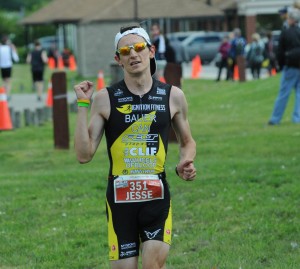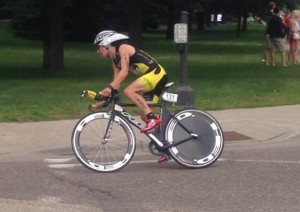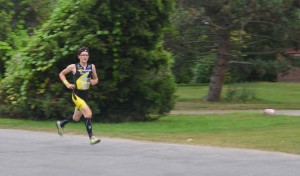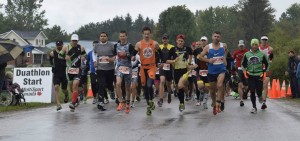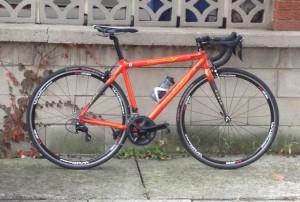To my readers, thank you for being so loyal this year. I don’t know exactly how many of you there are, but I am pretty sure I haven’t visited my own site over 3000 times since the beginning of the year…so thank you! I know I owe you a Season in Review post, considering the fact that my last race was 6 weeks ago!
2014 was a pretty wicked year. I won a bunch of races, held on for a bronze medal at Nationals, got humbled by the best the USA had to offer, felt the highs of peak fitness and the lows of the recovery doldrums, ran two HM’s and a 5000m on the track, started this website and got a solid following, started Ontario Duathlon Central and got a huge following, got muddy at Paris to Ancaster, then built a road bike. Wild ride!
I was going to use a “3 highlights, 3 low-lights, 3 lessons, 3 goals” format, but then I remembered where that idea came from…Cody Beals’ blog! Since he is a regular reader, I opted for another format. Month-by-month, here are 12 notable happenings, at least one for each month. I’ll wrap up with some broad goals for the next year in all areas of my life (because balance is key!).
JANUARY Race(s): None
Anecdote: January is cold and snowy. Training for your first half marathon is hard. Mixing the two can lead to some very sketchy long runs. Often consisting of several mind-numbing laps of the same short, semi-clear route. Or a retreat indoors to the treadmill. Luckily, this summer I work at a hotel with unlimited access to their treadmill and pool!
FEBRUARY Race(s): Grimsby Half Marathon (3rd, 1:18:01)
Highlight: First Half Marathon. I have never run anything longer than a 10k race, and even those have been few and far between. So the idea of a March half marathon felt daunting. Even moreso when, because of the dearth of tune-up options in February, my tune-up for the Chilly Half on March 2 would be a half marathon 2 weeks prior! I mainly solo’ed my way through awesome weather to a 1:18 HM debut.
MARCH Race(s): Chilly Half Marathon (19th, 1:16:24)
Lowlight: Second Half Marathon in snowy, -20 temperatures. After tentatively declaring my first half marathon (a controlled, monitored effort) a success, I took to the streets of Burlington two weeks later for the Chilly Half Marathon, hoping for a 1:15:XX clocking. I held strong through 10 miles (~57:30) before falling apart the last 5k. I have never wanted a race to end so badly as I slogged through slush and wind to the finish.
APRIL Race(s): Harry’s Spring Run-Off 8k (15th, 27:21), Paris to Ancaster 65k (tons of fun!)
Lesson learned: Sometimes it is best to just back off, put in some hard training, and do some fun races to break up the monotony of the hard work. April was some of my biggest training volume of the entire season, and I came into both races pretty hot. Harry’s is a favourite course of mine, with two killer hills in kilometers 4 and 8. Paris to Ancaster has been on my bucket list for sometime, and I had a blast slogging through the mud, towing groups of “cyclists” along the rail trail, and getting dirty. Having those two “races” to look forward to made the training easier.
MAY Race(s): Iron Hawk Duathlon (7th, 1:01:05), MSC Woodstock Sprint Duathlon (1st, 1:00:25)
Lesson learned: Sometimes a bit of forced rest can pay dividends. Before Iron Hawk, I had a sharp pain in my right foot, diagnosed as peroneal tendonitis. Recovery can take weeks or months, but rest, a massage, compression socks and some faith that I had done good work in April got me to the line. The pain stayed away for 61 minutes, and I held my own against pros like Sanders, Bechtel, and Forbes for a 7th place finish.
JUNE Race(s): MSC Welland Duathlon (1st, 1:24:24), McMaster Twilight 5000m (10th, 16:02.5)
Highlight: Repeat victory in Welland. Despite missing coach Tommy’s course record again, I successfully defended my title in Welland against a strong field. Save for super-cyclist Grahame Rivers, I would have been first off the bike after a 16:34 opening 5k run and a PB 46:58 30k ride, and I made the pass barely 1km into the last 5.25k run. Well-executed final tune-up before a big double in July.
JULY Race(s): Canadian Duathlon Championships (Toronto, 3rd, 2:01:45), USAT Duathlon Championships (St. Paul, 9th, 1:21:12)
Lowlight: Toronto Triathlon Festival. Despite an early season focus on short course racing, Nationals has always been a dream of mine, so I set of to Toronto for the race. However, complicated logistics, poor weather, stupid pre-race decisions, poor nutrition, and a sub-par first run put the nail in the coffin. I had thoughts of calling it quits after sitting up the last 10km on the bike, before limping home with a 3rd place finish.
Highlight: USAT Duathlon Championships. 6 days later was US Nationals, so a short memory was required. Redemption was sweet, as I stayed within myself on the first run, navigated the technical bike course, and flew through the field on my way to the 3rd fastest second run. The trip was an amazing experience. It was Emma’s first time out of Ontario, and my dad made the surprise trip from Edmonton to watch.
AUGUST Race(s): MSC Toronto Island Sprint Duathlon (1st, 1:02:28)
Lesson learned: Proper recovery is an underrated, often overlooked, but incredibly important factor in endurance training. After my Nationals double, I underestimated the time it would take for my body to get back to normal, needing a few extra recovery days here and there. A sketchy performance in Toronto and compromised recovery in the following weeks led to an inconsistent and sporadic build up to Lakeside.
SEPTEMBER Race(s): MSC Lakeside Sprint Duathlon (1st, 1:01:46)
Lowlight: Switching races in Lakeside. After spending a ton of time promoting and pumping up the international distance provincials at Lakeside and looking forward to being a part of it, I was forced to switch into the shorter, sprint distance race due to not feeling ready…both physically and mentally. It was quite a blow to have to miss the race, but I was able to finish off my MSC season undefeated, with 4 overall wins.
New experience: Watching races is actually quite a rewarding experience. After switching races, I had the opportunity to go to the Sunday races (the sprint was on Saturday) and represent Ontario Duathlon Central and MultiSport Canada by live blogging the event. I had more fun spectating than I did competing all year (possible exception being St. Paul). It was great to see the guys I wrote about all year in action.
OCTOBER Race(s): None
New experience: Building a road bike! After using my CX bike as an ill-suited road bike all year, and riding my TT bike entirely too much, I sold it and used the proceeds to accumulate the parts to build a road bike, including a 2nd Powertap. I took a vintage 2003 Klein Q Carbon Team frame and fought for days with my new arch nemeses, internal cable routing and cable tension, and came out with a sweet road machine!
2014 SEASON SUMMARY AND GOALS FOR 2015
So despite some bumps, I would consider my 2014 season a success. I doubled my career win count. I got my feet wet at the national and international level, and delivered some good results there. I took a leap of faith, quit my relatively comfortable job in professional sports and ventured into the abyss of life as an athlete.
Next year will be about taking the next step, seeking out some competition that I have never faced before and finding out where my limits are. I had my eyes opened this season as to what it takes to do this sport successfully, and my major focus this offseason will be about setting myself up for success in 2015. My three broad goals for 2015:
1) Become a more well-rounded athlete. Worlds in 2016 may very well be draft-legal for non-elites, and part of the reason I wanted a road bike was the develop the skills needed to be successful there if I choose to go. I also would like to dabble in the new Powerman USA series, likely at the September 27 event in Frankenmuth, MI. And finally, my training may end up being a little less…dry than it has been in past years.
2) Develop my brand into something attractive and lasting. It’s no secret that self-branding is almost as important as training in this sport, and I think 2014 was a good start. 2015 will be about kicking it into overdrive and leveraging my brand, sponsorship packages and intrinsic value into a strong network of support relationships.
3) Work on the forgotten aspects of training. I have an offseason strength training program, but it is more or less forgotten once race season rolls around. This is something I would like to continue deeper into my 2014 season. Starting in 2015, I also want to create a more stable routine, including consistent sleep hours, a predictably scheduled day, and a wholesome nutrition plan, building on the steps I took this year.
A season review post would not be complete without a HUGE thank you to my sponsors and supporters:
- Coach Tommy Ferris and Ignition Fitness for putting up with me these past two years, and making me the athlete I am today.
- Multisport Canada/Recharge With Milk Triathlon Series for providing an amazing proving ground for multisport athletes in Ontario.
- Skechers Performance, Felt Bicycles, Clif Bar Nutrition, GP8 Sportwater, Big Race Wheels Triathlon Wheel Rentals, Wheels of Bloor, Nimblewear Sports Apparel, and My Sports Shooter Event Photography for the support they give the Ignition Fitness athlete team
- Nate at Noble Cycles for taking great care of my race machines all year. Best mechanic in Hamilton!
- My girlfriend Emma for allowing me to drag her around all over the place, in all kinds of weather, and giving me the strength to continue. Not many people in the world would do that, and I appreciate that so much.
- My parents Martin and Tammi, my family out in Edmonton, and Emma’s entire family, especially Jayne and Roger, who do whatever it takes to get me to all of my races and give me the resources I need to compete at my best.
- And of course, my two super affectionate kitties, Samson and Delilah, for always having a purr or a headbutt of comfort for me when I need it.
Thanks for reading and keep an eye out for some fun features the next few months!
Until next time, keep Du’ing it!


